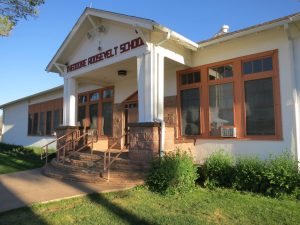- Slug: BC-CNS-Tribal Teacher Shortage. 680 words.
- Photo available (thumbnail, caption below).
By Alexander MacDonald
Cronkite News
WASHINGTON – Teachers have been in short supply across Arizona. Nowhere is that felt more than at schools run by Native American tribes.
Arizona has 34 such schools, plus 20 others operated by the Bureau of Indian Education, or BIE. Most of the tribally controlled schools are in remote parts of the state, far from towns or metropolitan areas. That makes finding teachers tough, and the pay and benefits tribes can offer – often less than other schools – makes it even more challenging.
“It’s extremely difficult. We do not have housing, we are 45 minutes away from a town, and the town is a tourist town so housing is very expensive,” said Laura Krause, the business manager and human resources director at Theodore Roosevelt School on the White Mountain Apache Reservation.
Theodore Roosevelt is a small day and boarding school that serves sixth through eighth graders. The school has about 130 students and six teaching slots – half of which are currently vacant.
“We lost three teachers but mostly they moved into new positions,” said Krause. “Two of them are doing other things at the school.”
Tribally controlled schools and BIE schools compete for the same pool of teachers, and the federally operated schools have a big advantage: access to the federal pension system.
Educators at tribally controlled schools are not federal employees. That’s a big disadvantage when those schools compete for the same talent.
Nor do tribal schools participate in the Arizona State Retirement System, which offers a pension available to public school teachers and employees across the state.
“We’re not part of a retirement program. We just have the 401(k),” said Krause. “So at this moment, we have a very hard time finding teachers if they’re not local, and even then there’s not many.”
A lawmaker from New Mexico has proposed a way to level the playing field, though so far it’s gained little traction in Congress., want to level the playing field.
The “Parity for Tribal Educators Act” authored by Rep. Gabe Vasquez, a Democrat, would let educators at schools run by federally recognized tribes participate in the federal employee pension system. The bill has 15 co-sponsors, 3 Republicans and 12 Democrats, including Rep. Ruben Gallego, D-Phoenix.
The National Indian Education Association has urged Congress to pass the bill, saying it would help with teacher recruitment and retention.
The BIE, which is part of the Department of the Interior, would cover the cost of the pensions.
That would address one of the challenges, though remoteness is also a major impediment in recruiting for many tribally run schools.
“We are so far away from the nearest town,” said Vernita Selestewa, the human resources technician at Hopi Junior Senior High School in Keams Canyon on the Hopi Reservation.
The school typically recruits teachers from Northern Arizona University in Flagstaff, more than 100 miles away.
Hopi Junior Senior High had about 430 students in 2021, the year of the most recent BIE report. The school has 24 teachers but needs another 10. Five of the vacancies are In the special education department, called Exceptional Student Services, according to Selestewa 5.
Turnover was abnormally high when the school year ended in May. The school relies on international teachers to fill openings, and many had expiring visas.
“It’s not normal but … they had to return to their country,” Selestewa said.
Hopi Junior Senior High School is run by the Hopi Tribal Council. Theodore Roosevelt School is run by the White Mountain Apache Tribal Council. Each gets funding through grants or contracts from the BIE, which also operates schools elsewhere in Arizona.
The tribally run schools can’t come close to the employee financial package offered by BIE.
The BIE runs another school on the White Mountain Apache Reservation, John F. Kennedy Day School, about 16 miles from Theodore Roosevelt. When that school is looking for new teachers, Krause said, “it’s a whole different thing; they’re actual government employees.”
